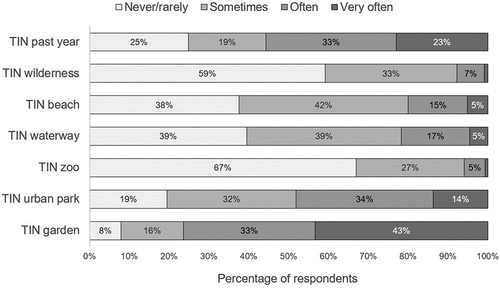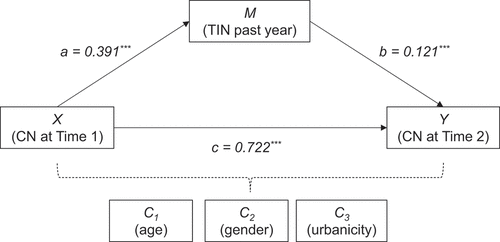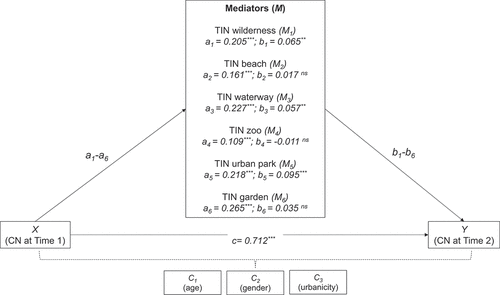Figures & data
Table 1. One-way ANOVA comparing CN scores (Time 1 and Time 2) across time spent in nature categories (never/rarely, sometimes, often, very often) for the seven time spent in nature variables. Planned contrasts (never/rarely vs sometimes + often + very often) are shown (n = 1036; df = degrees of freedom).
Figure 1. Percentage of respondents spending time in nature over the past year (never/rarely, sometimes, often, very often): generally (TIN past year); in protected or wilderness areas (TIN wilderness); at beach or coastal areas (TIN beach); at a lake, river or other waterway (TIN waterway); at a zoo, wildlife park, or botanical garden (TIN zoo); at an urban park (TIN urban park); and at a garden at home, or the garden of a friend, neighbour or family member (TIN garden) (n = 1036).

Figure 2. Mean CN scores (Time 1 and Time 2) for each category (never/rarely, sometimes, often, very often) of time spent in nature over the past year: generally (TIN past year [top]); in protected or wilderness areas (TIN wilderness), at beach or coastal areas (TIN beach); at a lake, river or other waterway (TIN waterway) [centre]; at a zoo, wildlife park, or botanical garden (TIN zoo), at an urban park (TIN urban park), and at a garden at home, or the garden of a friend, neighbour or family member (TIN garden) [bottom]. Error bars show standard error of the mean. Significant increases from CN at Time 1 to CN at Time 2 (p < 0.05) are indicated by asterisks (n = 1036).
![Figure 2. Mean CN scores (Time 1 and Time 2) for each category (never/rarely, sometimes, often, very often) of time spent in nature over the past year: generally (TIN past year [top]); in protected or wilderness areas (TIN wilderness), at beach or coastal areas (TIN beach); at a lake, river or other waterway (TIN waterway) [centre]; at a zoo, wildlife park, or botanical garden (TIN zoo), at an urban park (TIN urban park), and at a garden at home, or the garden of a friend, neighbour or family member (TIN garden) [bottom]. Error bars show standard error of the mean. Significant increases from CN at Time 1 to CN at Time 2 (p < 0.05) are indicated by asterisks (n = 1036).](/cms/asset/6438fcf2-c8c3-4d96-9d3a-11d217b24125/tbsm_a_2143570_f0002_b.gif)
Table 2. Hierarchical multiple linear regression analyses predicting connection with nature at Time 2 (CN at Time 2), from time spent in nature in the past year (TIN past year: Step 3, left), and time spent in different types of nature (wilderness, beach, waterway, zoo, urban park, garden: Step 3, right) [SE=standard error, 95% confidence intervals in brackets] (n = 1036).
Figure 3. Simple mediation analysis predicting connection with nature at Time 2 (Y) from connection with nature at Time 1 (×) with time spent in nature generally (M) as mediator. Age (C1), gender (C2), and urbanicity (C3) are entered as covariates (***p < 0.001).

Figure 4. Parallel multiple mediation analysis predicting connection with nature at Time 2 (Y) from connection with nature at Time 1 (×) with time spent in six types of nature (protected or wilderness area (M1); beach or coastal area (M2); lake, river or other waterway (M3); zoo, wildlife park, or botanical garden (M4); urban park (M5); own garden at home (M6) as mediators). Age (C1), gender (C2), and urbanicity (C3) are entered as covariates (*p < 0.05; **p < 0.01; ***p < 0.001; nsp > 0.05).

Appendix A
Download PDF (228.6 KB)Appendix B
Download PDF (349.5 KB)Appendix C
Download PDF (312.4 KB)Data availability statement
The data and syntax for this research are available at Open Science Framework (https://osf.io/3ca7f/?view_only=82164315080249d49d0eec6e5a34e21f)
